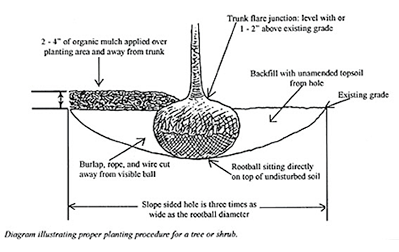Category: Maintenance Practices
In regards to the planting and maintenance of woody plants, many of the established cultural guidelines practiced by landscape professionals have undergone scrutiny in recent years. Based on research findings and field observations, many of these practices have been modified or changed in order to improve overall plant health in a landscape setting.
Improper planting techniques, particularly planting too deep, have been shown to be a major cause of tree mortality in managed landscapes. In addition, research has shown that accepted practices governing the size and shape of the planting hole and the nature of the backfill mixture require some modification.
Backfilling the Planting Hole
According to research, backfilling with soil dug from the planting hole is preferable to mixing the soil with large amounts of organic soil amendments such as peat moss, compost, etc. The addition of an organic soil amendment may be called for if the existing soil is of poor quality, such as excessively sandy or heavy clay soils or those consisting of undesirable fill material. Alternatively, quality topsoil, similar in texture to the existing soil, may be brought in and used for backfill.
While backfilling the hole, it has been customary to tamp the soil to avoid leaving large air pockets. However, this practice often results in the soil being packed so firmly as to drive out all the fine air spaces needed for a well-aerated soil. An alternative to tamping the soil would be to water the soil halfway through the backfill process and allow it to drain. When the water has drained away, resume backfilling and water again thoroughly. If the practice of tamping the soil is chosen, it should be done lightly so as to not compact the soil in the planting hole.
To complete the backfilling, smooth the surface soil and check to ensure that the trunk flare is completely exposed. (The structural roots should be within the top 3 inches of soil as measured 4 inches from the trunk.) Water the rootball and planting area immediately after backfilling.
Tree Wrapping
The bark on a tree or shrub is as important as skin to an animal. It acts as a barrier to exclude insects and disease organisms from the vascular system, which lies directly under the bark. Some bark injuries may occur because of damage from the sun (sunscald) or temperature extremes (frost cracks). For many years, it has been a common practice to use tree wrap on newly planted or thin-barked trees in an effort to reduce sun or temperature damage to the bark.
Research has found that some tree wraps may not provide the protection that was originally intended. In experiments using plastic tree guards on dogwoods, large numbers of dogwood borers were found under the guards while few were found in trees without guards. In addition, some tree wraps were found to retain excess moisture beneath the wrap. This may encourage fungal or bacterial growth, especially if there were pre-existing wounds in the trunk.
If tree wrap is to be used, it is recommended that appropriate material be selected, checked frequently, and the wrap be removed during periods of active growth.
It is hoped that these guidelines, together with the selection of appropriate and healthy plant material, will be of help in promoting improved plant health in the landscape.

Written by: Deborah C. Swanson – Revised – 01/2012
References:
• Appleton, B. L., Ph.D., “Questioning Tradition,” American Nurseryman, Sept. 1, 1993.
• Harris, R. W., Ph.D., Arboriculture: Integrated Management of Landscape Trees, Shrubs
and Vines, 2nd ed., Regents/Prentice Hall, Englewood Cliff s, NJ; LCC#91- 19477
• Kujawski, R., Ph.D., and Ryan, H.D., PhD., Fertilizing Trees and Shrubs, UMass Extension
IPM Fact Sheet series, July 2000.
• Shigo, A. L., Ph.D., Modern Arboriculture, National Arbor Day Foundation Bulletin
No. 19, 4 Denbow Road, Durham, NH 03824-3105.
• Watson, G. W., Ph.D. and Himelick, E. B., Principles and Practice of Planting Trees
and Shrubs, 1997. International Society of Arboriculture, PO Box GG, Savoy, IL 61874.
• Whitcomb, C. E., Ph.D., Establishment and Maintenance of Landscape Plants, Lacebark,
Inc., Stillwater, OK; LCC#87-50632
Newly Seeded Lawns
Setting Sprinkler System
How to Manage Your Turf Pruning Properly
Replacing a large tree is a difficult, but not impossible process. The tree in these photos is 25’ tall. It required special equipment and expertise. The pictures show just a few of the many steps it took to plant this stately tree.






